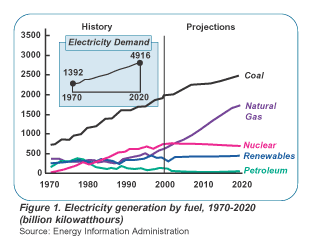At the end of December, The Energy Information Administration, a statistical agency of the U.S. Department of Energy, released 'The Annual Energy Outlook 2002' which forecasts energy supply, demand and prices through 2020. The report anticipates notable increases in electricity usage and carbon dioxide emissions and recognizes the trend toward more environmental awareness and increased governmental regulation in regard to the use of energy-efficient products and practices.
The report's projections are based on long-term factors, such as fuel supplies and the development of U.S. electricity markets, but also take into consideration current economic and political factors. The projections do not consider any future actions that might be taken to reduce carbon dioxide emissions. According to Copper Motor Rotor Project Manager Dr. John Cowie, switching to premium-efficiency motors for use in the home as well as in large industrial plants would greatly improve efficiency and, therefore, decrease carbon dioxide emissions.
 The report finds that overall energy consumption is expected to increase from 99.3 to 130.9 quadrillion Btu's over the next 18 years - an annual increase of 1.4 percent. Projected consumption in the commercial and transportation sectors is greatest. Commercial energy demand is expected to increase an average 1.7 percent annually, which coincides with an increase in office floor space of the same average annual percentage. Transportation energy demand is projected to increase an average of 1.9 percent annually. The report attributes that rise to a rapid increase in travel but a slower increase in efficiency. Energy demand in the industrial sector is projected to increase an average of 1.1 percent per year.
The report finds that overall energy consumption is expected to increase from 99.3 to 130.9 quadrillion Btu's over the next 18 years - an annual increase of 1.4 percent. Projected consumption in the commercial and transportation sectors is greatest. Commercial energy demand is expected to increase an average 1.7 percent annually, which coincides with an increase in office floor space of the same average annual percentage. Transportation energy demand is projected to increase an average of 1.9 percent annually. The report attributes that rise to a rapid increase in travel but a slower increase in efficiency. Energy demand in the industrial sector is projected to increase an average of 1.1 percent per year.
In order to meet the growing demand - and to offset the projected retirement of some of the existing fossil-fuel-fired and nuclear units - electricity generation from natural gas, coal and renewable fuels is also expected to increase ( Figure 1). Consequently, carbon dioxide emissions from energy use are also projected to rise at an average rate of 1.5 percent per year.
Over 2 billion tonnes of carbon dioxide is expected to be emitted by 2020 ( Figure 2). This figure is 470 million tonnes higher than projected was last year, due to the higher energy demand in the aforementioned commercial and transportation sectors along with an increase in coal-fired energy generation.

"The levels of efficiency achieved through applying copper to the rotors of medium-power motors surpass those of any premium-efficiency motor available to date," explains Dr. Cowie. Therefore, carbon dioxide emissions could be greatly reduced by replacing less efficient motors with ones containing copper rotors.
